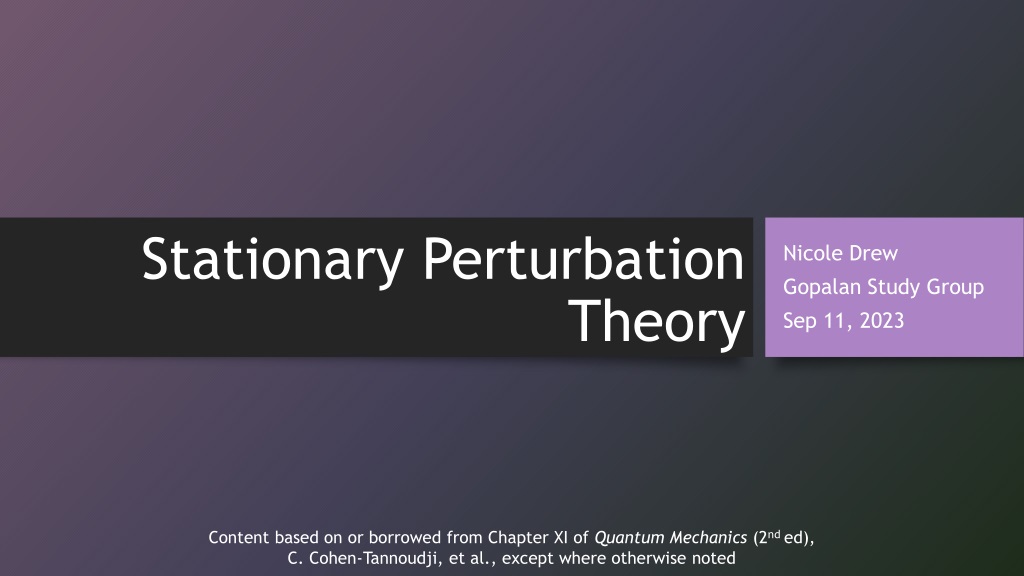

0 likes | 12 Views
Perturbation theory in quantum mechanics is an approximation method used to solve the Schrödinger equation when exact solutions are challenging. It is applicable to both time-independent and time-dependent scenarios, degenerate and non-degenerate states. The theory involves expanding eigenvalues and eigenstates in powers of a small parameter, allowing for the calculation of energy corrections and state vectors. Non-degenerate and degenerate cases are addressed differently, with methods for finding corrections depending on the level of degeneracy present.

E N D
Stationary Perturbation Nicole Drew Gopalan Study Group Sep 11, 2023 Theory Content based on or borrowed from Chapter XI of Quantum Mechanics (2nd ed), C. Cohen-Tannoudji, et al., except where otherwise noted
Perturbation Theory in Quantum Mechanics • What? • An approximation scheme for solving the Schrödinger equation (SE) • Robust—can be used for: • time-independent SE (TISE) and time-dependent SE (TDSE) • degenerate and non-degenerate states • Why? • Exact solutions to the SE are not always tractable (or possible) • When? • When our Hamiltonian is similar to one whose solutions we know, e.g. • Square Well (infinite or finite) • Harmonic Oscillator • Dirac-Delta • Coulomb (Hydrogen Atom à la Chapter VII) • How?
Basics of Perturbation Theory Can apply perturbation theory when our system Hamiltonian can be written as “unperturbed Hamiltonian” wave functions and energies are known “perturbation” energy scale much smaller than
Basics of Perturbation Theory • Properties of perturbation : • can be time-independent (“stationary”, Ch.XI) or -dependent (Ch.XIII) • matrix elements are smaller than differences between eigenvalues of • can be expressed as product of real, dimensionless parameter and operator whose matrix elements are of comparable scale to • Assumptions about unperturbed Hamiltonian : • Eigenstates and eigenvalues are known and orthonormal • Energies form a discrete spectrum (indexed by ) • Associated eigenstates may be degenerate (indexed by )
Basics of Perturbation Theory Method of perturbation theory consists of expanding the eigenvalues and eigenstates of in powers of and keeping only a finite number of terms. Begin by writing as a function of When ,
Stationary Perturbation Theory Given a system Hamiltonian , we want to find wave functions and their energies that solve the TISE: Assumption: and can be expressed in powers of
Stationary Perturbation Theory Insert these definitions of and into the TISE Equate terms of equal powers (“orders”) of to produce a system of equations 0thorder: 1storder: 2ndorder: qthorder:
Stationary Perturbation Theory Assume that is normalized, and its phase is such that is real. To 0thorder: To 1storder: To 2ndorder: To qthorder:
Non-Degenerate Stationary Perturbation Theory Consider a particular nondegenerate eigenvalue of , with associated eigenstate • Want to determine how the addition of modifies this state and its energy • When , we require and . • This implies:
First-Order Correction to Energy Project 1st-order equation onto the vector The first-order correction to a non-degenerate energy is equal to the mean value of the perturbation in the unperturbed state .
First-Order Correction to State Vector Project 1st-order equation onto all remaining eigenvectors
First-Order Correction to State Vector The first-order correction to the state vector is a linear superposition of all unperturbed states other than . is said to “mix” or “couple” the unperturbed states
Second-Order Corrections to Energy and State Project 2nd-order equation onto the vector Project 2nd-order equation onto the remaining vectors to obtain a formula for . It is customary to estimate the energy to one higher order than the wave function.
Degenerate Stationary Perturbation Theory Consider an eigenvalue , that is -fold degenerate • Often, will generate multiple distinct sublevels of , counted by (must be ≤ • “lifting degeneracy” ) • To approximate the state vectors and energies to 0thand 1storder, project the 1st-order equation onto the state vectors • Insert “closure relation”
Degenerate Stationary Perturbation Theory is orthogonal to all for which Construct a new matrix • elements: • row index and column index limited to the subspace of states associated with • • Finding corrections is now equivalent to diagonalizing the matrix •